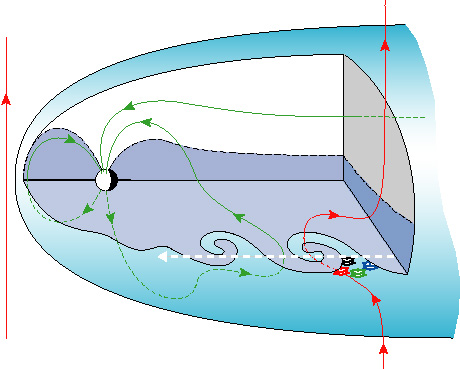Huge Swirls of Hot Gas Found Above Earth

Pockets of superheated gas several times the size of Earth have been discovered swirling like bathtub drains high above the planet.
The vortices seem to suck high-energy particles from the Sun into Earth's otherwise protective magnetic shield. The finding should help solve a longstanding mystery.
The Sun spits out a constant stream of charged particles known as the solar wind. It travels at nearly 1 million mph and sometimes much faster. Earth's magnetic field blocks most of these particles, which slip past the planet around a teardrop-shaped magnetosphere.
When Earth's magnetic field is aligned opposite to that of the solar wind, gaping holes can allow the energized particles to pour in and collect in an outer region of the magnetosphere called the boundary layer. Scientists already knew this, and during solar storms the gaps can force a rain of particles at lower altitudes, generating tremendous displays of sky lights called auroras while threatening satellites and terrestrial power grids.
But since 1987, scientists have also known that when the magnetic fields are aligned, and the magnetosphere ought to be impenetrable, the boundary layer is actually fuller.
New observations by the European Space Agency's Cluster mission of satellites found the likely cause.
Like wind over water, the hot solar wind, called plasma, rubs against plasma at the magnetopause -- the outer limit of Earth's magnetosphere, explains Hiroshi Hasegawa of Dartmouth College. "At the magnetopause, the interaction of fast streaming solar wind plasma and stagnant plasma in the magnetosphere creates the vortices," Hasegawa said in an e-mail interview.
Breaking space news, the latest updates on rocket launches, skywatching events and more!
The swirls of electrified gas are nearly 24,850 miles (40,000 kilometers) in diameter.
Theory predicted the vortices, but they hadn't been seen until now. Theory also predicts the vortices might pull charged particles into the magnetosphere, but scientists aren't sure how.
"We don't know yet exactly how the vortices bring the solar wind into the boundary layer," Hasegawa said. "But this would be similar to what happens when cresting waves on the surface of the ocean crash: Large quantities of air are engulfed into the seawater."
Hasegawa said it takes roughly 10 minutes for a vortex to form and collapse, and he suspects they are created continuously when conditions are favorable. Other unknown mechanisms might also contribute to filling the boundary layer, he said, adding that current space-based observatories won't answer all the questions.
The results are detailed in the Aug. 12 issue of the journal Nature.
- Live Sun Cams
- Mysteries of the Sun
- Top 10 SOHO Images of the Sun

Rob has been producing internet content since the mid-1990s. He was a writer, editor and Director of Site Operations at Space.com starting in 1999. He served as Managing Editor of LiveScience since its launch in 2004. He then oversaw news operations for the Space.com's then-parent company TechMediaNetwork's growing suite of technology, science and business news sites. Prior to joining the company, Rob was an editor at The Star-Ledger in New Jersey. He has a journalism degree from Humboldt State University in California, is an author and also writes for Medium.

